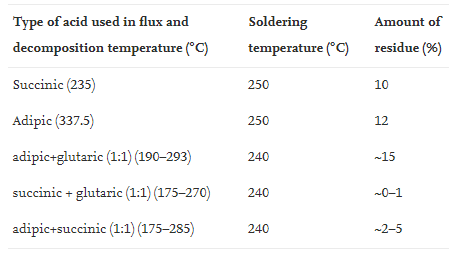Characteristics of No-Clean Solder Paste (2): Analysis of Corrosive Mechanism of Residues
Characteristics of No-Clean Solder Paste (2): Analysis of Corrosive Mechanism of Residues
Continued from "Characteristics of No-Clean Solder Paste (1): Analysis of Corrosive Mechanism of Residues"
The activators of the no-clean solder pastes, such as carboxylic acid, will generate acidic ion residues after reacting with oxide layers. The residue combines with the water in the air to form an acidic solution that will corrode the pads. As mentioned in the last article, the factors affecting the corrosivity of the residue of the active agent include solubility, decomposition temperature, deliquescence and efflorescence relative humidity, number of functional groups, and molecular chain length. This article will continue to analyze other factors that affect the corrosivity of residues.
1. Factors affecting the corrosivity of no-clean solder pastes after soldering
1.1 Decomposition temperature of weak organic acids
The high decomposition temperature of the organic acid component of the no-clean solder paste prevents the organic acid of the flux from volatilizing completely during the reflow process, leaving more residues. Therefore, proper use of organic acids with lower decomposition temperatures can relieve the residue problem. Wakeel et al. summarized the effect of the decomposition temperature of a series of carboxylic acids on the number of residues. Using mixed organic acids will result in a lower decomposition temperature and a small number of residues. For example, the mixed-use of succinic acid and glutaric acid will significantly reduce the decomposition temperature and the residues.
Table 1. Effect of organic acid decomposition temperature of different fluxes on residues.

1.2 Boiling point of solvents
Generally, solvents are added into flux to adjust the viscosity of solder paste, including volatile organic compounds-based solvents and solvents without volatile organic compounds. The solvent will completely evaporate during soldering. Some studies show that the common boiling points of the solvents will be adjusted between 150-260 ℃ (Alvarez et al., 2017). If the boiling point of the solvent is high (above the peak reflow temperature), the solvent will turn into residue on the pad after soldering.
1.3 Acidity coefficient
The acidity coefficient indicates the strength of an acid or its tendency to ionize in solution. A lower acid dissociation constant means that acid ions are easier to dissociate in water, forming solutions that are more acidic and leaving more corrosive ionic residues. Verdingovas et al. conducted insulation resistance tests on soldering surface insulating resistance for adipic acid, succinic acid, palmitic acid, glutaric acid, and mixed activator (succinic acid adipic acid). They found that palmitic acid and adipic acid had higher acidity coefficients and lower leakage currents.
1.4 Effect of soldering process on residues
At present, reflow soldering and wave soldering are commonly used in electronic component packaging. As shown in Figure 1, the residues generated by wave soldering are much more than reflow soldering. The organic acid will spread around the solder joints during reflow soldering. Consequently, reflow soldering can reduce the occurrence of solder joint leakage current. Higher soldering temperatures also help to inhibit residues by accelerating the decomposition and evaporation of activators and solvents, respectively. In addition, the proper duration of the soak zone of reflow soldering can allow the solvent to evaporate entirely.

Figure 2. Amount of residues generated by different soldering methods.
Fitech can produce high-quality no-clean solder pastes regarding customer needs. The no-clean solder paste products generate less residue after soldering and can produce solder joints with high reliability. Welcome to the official website for more information.
Reference
Alvarez, V., Beaulieu, P.Y., Lee, K.W., Nah, J.W. & Turlapati, L. (2017), “No clean flux composition and methods for use thereof”, U.S. Patent Application.
Verdingovas, V., Jellesen, M.S., Rizzo, R., Conseil, H. & Ambat, R. (2013). “Impact of hygroscopicity and composition of solder flux residue on the reliability of PCBA under corrosive conditions”.
Wakeel, S., Haseeb, A.S.M.A., Afifi, M.A., Bingol, S. & Hoon, K.L. (2021). “Constituents and performance of no-clean flux for electronic solder”. Microelectronics Reliability, vol.123.


















 Back to list
Back to list



